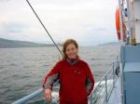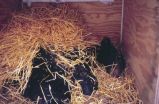(Press-News.org) In the U.S., even zoo gorillas need to switch to a heart-healthy diet.
"A lot are dying of heart disease, we believe like humans," said Elena Hoellein Less, a PhD candidate in biology at Case Western Reserve University.
In fact, heart disease is the number one killer of male Western lowland gorillas – the only species of gorillas in North American zoos.
After Brooks, a 21-year-old gorilla, died of heart failure at Cleveland Metroparks Zoo in 2005, Less and other researchers here took a hard look at how the animals' lifestyle affects their health. Less now leads an effort to counter the killer disease by returning the primates to a diet more akin to what they'd eat in the wild.
Gone is the bucketful of vitamin-rich, high-sugar and high-starch foods that zoos used for decades to ensure gorillas received enough nutrients.
Instead, Cleveland's Mokolo and Bebac receive a wheelbarrow of romaine lettuce, dandelion greens and endive they gently tear and bite, alfalfa hay they nimbly pick through, young tree branches they strip of succulent bark and leaves, green beans, a handful of flax seeds, and three Centrum Silver multivitamins tucked inside half a smashed banana.
Instead of spending about a quarter of their day eating the old diet, the pair now spends 50 to 60 percent of each day feeding and foraging, about the same amount of time wild gorillas forage.
Although they take in twice as many calories on the new diet, after a year, the big boys of the primate house have dropped nearly 65 pounds each and weigh in the range of their wild relatives.
"We're beginning to understand we may have a lot of overweight gorillas," said Kristen Lukas, an adjunct assistant professor of biology at Case Western Reserve and chair of the Gorilla Species Survival Plan® (SSP®) for the Association of Zoos and Aquariums. The organization serves 52 zoos in the U.S. and Canada in a coordinated effort to improve the health and survival of the nearly 350 gorillas in the population.
"And, we're just recognizing that surviving on a diet and being healthy on a diet are different," said Lukas, who is also curator of Conservation and Science at Cleveland Metroparks Zoo. "We've raised our standards and are asking, are they in the best condition to not only survive but to thrive?"
Less is one of five Case Western Reserve graduate students in the biology program who are involved in research linking behavior to the health of zoo animals, a unique program among U.S. zoos, Lukas said.
At the same time Less has been monitoring the diet and resulting habits of the gorillas, she's been measuring the amount of fat on the backs of the apes and attempting to discern what benefits against heart disease they may be gaining with the new diet, using biomarkers of insulin resistance and inflammation as guides.
She's also creating a body mass index for the animals, similar to that used to gauge healthy weight and makeup in humans.
Though these zoo gorillas now weigh about the same or sometimes more than their wild counterparts, "we believe those in the wild have more muscle," Less said.
If the continuing study finds that to be true, she said, "The next step is exercising gorillas in zoos."
In addition to dropping weight and becoming active feeders, the gorillas also dropped a habit seen only in zoo gorillas, a habit that literally turned patrons away. Whether to taste sugar again and again, or to take up time not spent foraging or because large amounts of sugar and starch didn't sit well; on the old diet, the gorillas would repeatedly spit up and then eat what they'd just spit up.
"That behavior has been completely eliminated with the new diet," Less said.
Colleagues at other Gorilla SSP® institutions have allowed versions of the new diet to be tested at zoos in Columbus, North Carolina, Toronto and Seattle. Results are expected later this year.
Should the larger sample prove the diet provides health benefits, the Gorilla SSP® may endorse high-fiber foraging at zoos nationally and internationally, Lukas said.
INFORMATION:
Click on the link below to watch a video on the gorilla research:
http://www.youtube.com/watch?v=P9A74LvPxU8
For a broadcast-quality version of this video without graphics, contact Mary Gerity at mary.gerity@case.edu. To set up an interview, contact Kevin Mayhood at kevin.mayhood@case.edu
END
(Santa Barbara, Calif.) –– Siberia's Lake Baikal, the world's oldest, deepest, and largest freshwater lake, has provided scientists with insight into the ways that climate change affects water temperature, which in turn affects life in the lake. The study is published in the journal PLoS ONE today.
"Lake Baikal has the greatest biodiversity of any lake in the world," explained co-author Stephanie Hampton, deputy director of UC Santa Barbara's National Center for Ecological Analysis & Synthesis (NCEAS). "And, thanks to the dedication of three generations of a family of ...
RIVERSIDE, Calif. – Asian Americans are widely viewed as "model minorities" on the basis of education, income and competence. But they are perceived as less ideal than Caucasian Americans when it comes to attaining leadership roles in U.S. businesses and board rooms, according to researchers at the University of California, Riverside.
In a groundbreaking study, researchers found that "race trumps other salient characteristics, such as one's occupation, regarding perceptions of who is a good leader," said Thomas Sy, assistant professor of psychology at UC Riverside and ...
ST. PAUL, Minn. – People with multiple sclerosis (MS) may find it harder to learn, remember or process information on warmer days of the year, according to new research released today that will be presented at the American Academy of Neurology's 63rd Annual Meeting in Honolulu April 9 to April 16, 2011.
"Studies have linked warmer weather to increased disease activity and lesions in people with MS, but this is the first research to show a possible link between warm weather and cognition, or thinking skills, in people with the disease," said study author Victoria Leavitt, ...
New research from the University of Pennsylvania is beginning to crack the code of which strain of flu will be prevalent in a given year, with major implications for global public health preparedness. The findings will be published on February 17 in the open-access journal PLoS Genetics.
Joshua Plotkin and Sergey Kryazhimskiy, both at the University of Pennsylvania, conducted the research with colleagues at McMaster University and the Institute for Information Transmission Problems of the Russian Academy of Sciences. Plotkin believes that his group's computational ...
The portion of the brain responsible for visual reading doesn't require vision at all, according to a new study published online on February 17 in Current Biology, a Cell Press publication. Brain imaging studies of blind people as they read words in Braille show activity in precisely the same part of the brain that lights up when sighted readers read. The findings challenge the textbook notion that the brain is divided up into regions that are specialized for processing information coming in via one sense or another, the researchers say.
"The brain is not a sensory machine, ...
To protect the health of future generations, body keeps a careful watch on its precious and limited supply of eggs. That's done through a key quality control process in oocytes (the immature eggs), which ensures elimination of damaged cells before they reach maturity. In a new report in the February 18th Cell, a Cell Press publication, researchers have made progress in unraveling how a factor called p63 initiates the deathblow.
In fact, p63 is a close relative of the infamous tumor suppressor p53, and both proteins recognize DNA damage. Because of this heritage it ...
Researchers have found an altogether unexpected connection between a hormone produced in bone and male fertility. The study in the February 18th issue of Cell, a Cell Press publication, shows that the skeletal hormone known as osteocalcin boosts testosterone production to support the survival of the germ cells that go on to become mature sperm.
The findings in mice provide the first evidence that the skeleton controls reproduction through the production of hormones, according to Gerard Karsenty of Columbia University and his colleagues.
Bone was once thought of as a ...
This release is available in French, Spanish, Arabic, Japanese and Chinese on EurekAlert! Chinese.
Several American black bears, captured by the Alaska Department of Fish and Game after wandering a bit too close to human communities, have given researchers the opportunity to study hibernation in these large mammals like never before. Surprisingly, the new findings show that although black bears only reduce their body temperatures slightly during hibernation, their metabolic activity drops dramatically, slowing to about 25 percent of their normal, active rates.
This ...
New Haven, Conn.—More than 50 years after the invention of the laser, scientists at Yale University have built the world's first anti-laser, in which incoming beams of light interfere with one another in such a way as to perfectly cancel each other out. The discovery could pave the way for a number of novel technologies with applications in everything from optical computing to radiology.
Conventional lasers, which were first invented in 1960, use a so-called "gain medium," usually a semiconductor like gallium arsenide, to produce a focused beam of coherent light—light ...
That feeling of being in, and owning, your own body is a fundamental human experience. But where does it originate and how does it come to be? Now, Professor Olaf Blanke, a neurologist with the Brain Mind Institute at EPFL and the Department of Neurology at the University of Geneva in Switzerland, announces an important step in decoding the phenomenon. By combining techniques from cognitive science with those of Virtual Reality (VR) and brain imaging, he and his team are narrowing in on the first experimental, data-driven approach to understanding self-consciousness.
In ...


